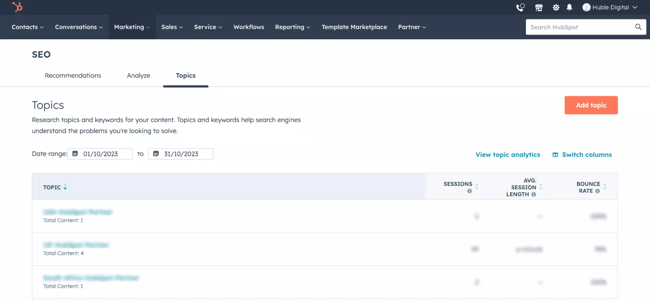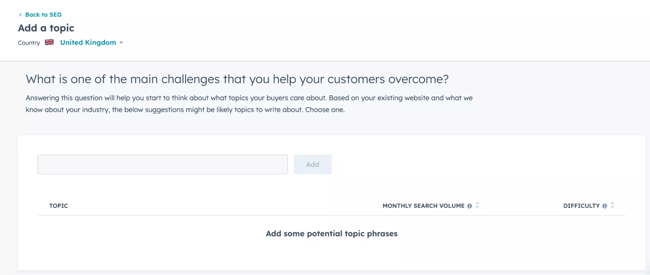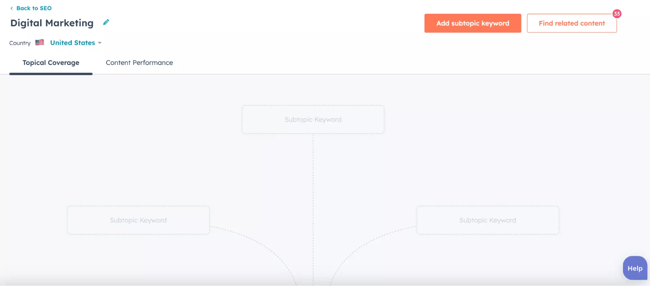This article explores the HubSpot topic cluster tool, a game-changer in how we approach content strategy and SEO, and a clearer way to measure the return on investment of your content creation efforts.
In the constantly evolving world of SEO, staying ahead of the curve is crucial for any business looking to enhance its online presence.
One innovative approach that has emerged is the use of topic clusters – a strategy that streamlines content production and significantly boosts SEO performance.
If your website content struggles to attract and grow monthly organic traffic from search engines, then topic clusters represent a long-term approach that can give it a much-needed boost.
Learn how Huble helps clients like DTS Solutions and Atlas Copco grow their rankings and organic traffic through content.
What is the HubSpot topic cluster tool?
At its core, the HubSpot topic cluster tool is designed to transform the way businesses organize and optimize their content. Traditional SEO strategies often focus on individual keywords, but this tool shifts the focus to topics – a more holistic and user-centric approach.
It enables marketers to create 'clusters' of content around a central theme, linked to a comprehensive 'pillar' page, thereby enhancing the depth and breadth of their content on specific subjects.
The tool simplifies the process of identifying core topics and associated subtopics, making it easier for content creators to plan and structure their content.
By interlinking related articles and resources, the HubSpot tool helps in building a network of content that is both user-friendly and search engine optimized.
The benefits of topic clusters
Topic clusters are not just a new SEO tactic; they represent a paradigm shift in content creation and organization.
For low volume, low competition and extremely niche keywords, you can still find success writing a single piece of content to target those searches.
But with so many websites investing in SEO, the broader, high-volume topics become increasingly more competitive, making it difficult for a lone piece of content to rank well.
Search engines know that the best results are those provided by trustworthy, authoritative and expert sources. This is becoming increasingly important as more low-quality, AI-generated content gets published.
Creating a cluster of content on a subject is your way of demonstrating your website contains this depth of knowledge and expertise.
By grouping related pieces of content around a central theme, businesses can:
- Improve search engine rankings: Search engines like Google are increasingly favouring topic-based content, as it provides more comprehensive answers to user queries. This means that well-organized topic clusters can significantly boost your visibility in search results.
- Enhance user experience: With all related content interlinked and easily navigable, users can effortlessly find all the information they need on a particular topic. This not only increases the time spent on your site but also positions your brand as a knowledgeable authority in your field.
- Streamline content strategy: The HubSpot topic cluster tool aids in identifying gaps in your content, allowing for a more focused and effective SEO content strategy. It ensures that all aspects of a topic are covered, making your content more thorough and valuable.
How to use HubSpot's topic cluster tool
The HubSpot topic cluster tool isn't just powerful; it's also user-friendly. Here’s how you can start leveraging it to transform your content strategy:
1. Accessing the tool
Located within HubSpot’s comprehensive suite of “SEO” tools located in the “Website” section of the “Marketing” menu, you can find the topic cluster tool under the “Topics” tab.

Once you're in, you’ll find an intuitive interface that guides you through the process of creating and managing your topic clusters.
2. Identifying core topics
Start by identifying the 'pillar' content. This is a broad topic that is central to your business and holds significant search potential.
For example, if you're a digital marketing firm, a core topic could be 'Inbound marketing' or 'SEO strategies'.

Add this keyword to the tool, by clicking the “Add topic” button.
Pro tip: Don’t forget to set the locale you’re targeting as search engines return different results based on several factors, including the searcher's location.
3. Brainstorming subtopics
Once your core topic is set, it's time to brainstorm subtopics for your cluster content. These are the more specific, detailed keywords related to your pillar content.
Your cluster content can come in all kinds of forms, from blog content, help articles, and guides to landing pages, videos, podcasts, case studies or your main website pages.

Using the HubSpot tool, you can identify these subtopics based on search trends, relevance to your core topic, and their potential to drive traffic.
Note: At present, the machine learning models that generate suggestions for subtopic keywords are primarily designed for English. For other languages, subtopic keyword recommendations are sourced based on the available locales from the SEO tool SEMRush.
4. Creating content
After mapping out your subtopics, develop high-quality, informative content for each. This content should not only address the subtopic in depth but also link back to your pillar page, creating a cohesive network of information.
5. Organizing and linking content
The HubSpot topic Cluster tool provides a visual reference for you to keep track of which pages link your subtopics to the pillar content, effectively creating a topic cluster. This interlinking is crucial as it signals to search engines the hierarchy and relationship between the pillar and subtopic content.
Search engines use it to understand how your content is related, but it also has a user benefit, guiding them to the next most relevant step for their needs, keeping them engaged with your site and ideally leading them towards a conversion point.
Selecting core topics
Selecting the right core topics is pivotal to the success of your topic cluster strategy. Here are some tips to guide you in this process:
- Align with business goals: Your core topics should reflect your business's key areas of expertise and the interests of your target audience.
- Research keywords: Use SEO tools to research keywords related to your business. Look for those with higher monthly search volumes and align them with your core topics.
- Analyse competitors: See what topics your competitors are focusing on. This can provide insights into industry trends and gaps you can fill. But it also enables you to realise if a topic has been covered extensively already. Writing on a well-covered topic is less likely to deliver meaningful results, unless you have a very high Domain Authority, or are bringing something revolutionary or exciting to the table that hasn’t been covered already.
Mapping out subtopics
With your core topics in hand, the next step is to map out relevant subtopics. This involves:
- Understanding the pain points of your target audience: This can help you visualise the types of keywords they would search for and the content that could best help them realise that your company’s products, solutions or services are what they need.
- Keyword research: For each core topic, identify long-tail keywords that represent specific questions or issues your target audience might have.
- Identifying content gaps: Look at your existing content and identify gaps related to your core topics. Filling these gaps can strengthen your topic clusters.
- Diversifying formats: Consider different formats for your subtopic content like blog posts, infographics, and videos. Also, think about creating content for different stages of the buyer journey and sales funnel. This diversity can cater to various user preferences and ensure your content is relevant, no matter what stage of their journey they are in.
5 best practices for pillar pages
Pillar pages are the cornerstone of a successful topic cluster strategy, serving as comprehensive, authoritative resources on a specific subject.
Let’s explore some best practices for effective pillar page designs that help you create impactful pillar content.
1. Comprehensive and informative
A standout pillar page is characterised by its depth and breadth of information. For instance, consider a pillar page on "Digital Marketing Trends."
It effectively covers a wide range of subtopics, from social media strategies to data analytics, offering readers a one-stop resource.
This approach not only boosts SEO but also positions your brand as a knowledgeable authority in the field.
2. User-friendly layout
The best pillar pages are those that are easy to navigate. They typically feature a clean layout with well-organised sections, allowing readers to effortlessly find the information they need.

Image source: Typeform Blog
Clear headings, a table of contents, and a smooth flow of topics enhance the user experience, encouraging longer engagement with the content.
For example, Typeform has done a great job of structuring the content in a way that’s easy to digest. It’s bold, full of quotes, and signposted with strong headers, bullets and pull-out sections of text.
3. Engaging visuals
Effective pillar pages often include engaging visuals like infographics, videos, and charts. These elements not only break up the text but also provide alternative ways to digest complex information.
For example, a pillar page on "Sustainable Business Practices" could include infographics depicting environmental impact statistics, making the data more accessible and engaging.
4. Strong internal linking
Another key feature of successful pillar pages is the strategic use of internal links. These links connect the pillar page to related subtopic content within the cluster, creating a seamless network of information.
This not only aids in navigation but also significantly enhances SEO by establishing a clear, interconnected content structure.
5. Incorporate CTAs
Lastly, effective pillar pages skillfully incorporate CTAs. Whether it’s encouraging readers to download a related eBook, sign up for a webinar, or contact the company for more information, CTAs can turn a pillar page into a powerful lead generation tool.
By following these best practices, you can create pillar pages that not only rank well in search engines but also genuinely resonate with and provide value to their audience.
Bonus Tip: Your pillar page should evolve as your topic cluster expands. When you launch new cluster content it needs to link to the Pillar, but should also ideally be linked to from your pillar page as well. Revisit your pillar and draft a new paragraph or section to summarise your cluster content, how it relates to the core topic and what value it delivers to the reader.
For more inspiration, check out our top 5 pillar page designs.
Understanding the cost of creating pillar pages
Pillar pages are a vital part of any robust content strategy, especially when implementing a topic cluster approach.
However, a common question that arises is: How much does it cost to create a pillar page? The answer can vary depending on several factors.
- Content creation: The heart of a pillar page is its content. The cost here depends on whether you're producing in-house or outsourcing to professionals. High-quality, well-researched content that covers a topic comprehensively requires significant time and expertise. Depending on the depth and breadth of the content, as well as the writer's experience, prices can range considerably.
- Design and layout: A visually appealing and easy-to-navigate design is crucial for keeping readers engaged. Professional designers can help ensure your pillar page is not only informative but also aesthetically pleasing and user-friendly. The complexity of the design, interactivity elements, and branding integration all contribute to varying costs in this area.
- SEO and keyword research: Integrating effective SEO practices, including comprehensive keyword research, is essential for ensuring your pillar page ranks well on search engines. While some businesses might have in-house SEO expertise, others might need to invest in SEO tools or consultancy services, which can add to the overall cost.
- Multimedia elements: Incorporating multimedia elements like videos, infographics, and interactive charts can significantly enhance a pillar page. These elements, while not always necessary, can increase engagement and provide a richer user experience. Creating high-quality multimedia content can add to the cost, depending on the level of sophistication required.
- Maintenance and updates: A pillar page is not a one-time cost. Keeping the content updated and ensuring it remains relevant and accurate over time requires ongoing investment. This might involve periodic reviews and updates, which can incur additional costs.
Reviewing your topic cluster performance in HubSpot
Once your topic clusters are live, monitoring their performance is crucial. HubSpot's topic cluster tool provides valuable insights into how your content is performing. Here’s what to look for:
- Traffic and engagement metrics: Keep an eye on the traffic each piece of content receives, as well as engagement metrics like time spent on page and social shares. This data helps gauge the relevance and appeal of your content.
- SEO performance: Track how your content ranks for the targeted keywords. Observe changes in rankings and identify opportunities for further optimisation.
- Link analysis: Examine the internal and external linking structure of your topic clusters. Effective linking within a cluster can significantly boost SEO performance.
Key advantages of using HubSpot's topic cluster tool
There are several key benefits of using topic clusters, these include:
- Enhanced SEO: By organizing content into topic clusters, you improve your site’s architecture, making it easier for search engines to crawl and index your content.
- Focused content strategy: The tool helps in identifying content gaps and redundancies, allowing for a more streamlined and effective content strategy.
- Better user experience: Topic clusters make it easier for users to find the information they’re looking for, improving the overall user experience and potentially increasing conversion rates.
- Data-driven decisions: With analytics and performance data, you can make informed decisions on content creation and optimisation.
Huble: your partner in SEO and topic cluster optimisation
Creating a solid content strategy with well-organized topic clusters is more important than ever. However, navigating the complexities of SEO and topic cluster creation can be daunting.
That's where Huble comes in. As experts in SEO consultancy, we specialize in helping businesses harness the full potential of tools like HubSpot's topic cluster tool.
Our team at Huble offers personalized consultancy services to help you:
- Create impactful topic clusters: We assist in identifying the right core topics and subtopics that resonate with your audience and align with your business goals.
- Optimize existing content for SEO: Leveraging our SEO expertise, we ensure that your content is not just well-written but also well-optimized for search engines.
- Create new content for SEO: Our expert team of SEO content creation specialists can understand your buyer personas’ needs and craft copy that they (and search engines!) will find helpful and informative.
- Monitor and refine strategies: With ongoing analysis and insights, we help refine your content strategy for continuous improvement and better results.
Interested in elevating your content strategy and making your mark in the digital world?
Speak with our team to learn how we can help you create and optimize your topic clusters, driving more organic traffic and positioning your brand as a thought leader in your industry.











.png)





